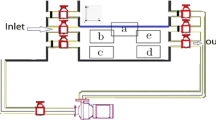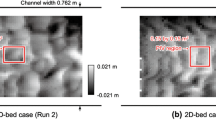Abstract
The paper describes a novel technique which enables evaluation of sediment fluxes on the upper layer of a granular bed by means of separate measurements of concentration and velocity of the moving particles. Specific elaboration techniques based on digital image processing were applied to films of the solid fluxes, allowing for automatic measurement. Sediment concentration was measured via a technique based on image subtraction and following proper filtering procedures, while grain velocity was measured by Particle Image Velocimetry. The method was applied in laboratory experiments of one dimensional bed load; the solid discharges measured by the proposed image processing technique were compared to those obtained by manual count of the grains passing over a fixed plate used as a sight. After calibration of the automatic technique, dimensionless solid discharges ranging from 1.0 × 10−3 to 1.2 × 10−1 were measured with a maximum error as large as 25%. The technique proposed also enables measurement of the time variation of the quantities and the two dimensional direction of sediment motion, for a complete characterization of grain kinematics in solid transport processes.












Similar content being viewed by others
References
Admiraal DM, Garcìa MH, Rodrìguez JF (2000) Entrainment response of bed sediment to time-varying flows. Water Resour Res 36:335–348
Drake TG, Shreve RL, Dietrich WE, Whiting PJ, Leopold LB (1988) Bedload transport of fine gravel observed by motion-picture photography. J Fluid Mech 192:193–217
Fernandez Luque R, van Beek R (1976) Erosion and transport of bed-load sediment. J Hydr Res 14:127–144
Hu C, Hui Y (1996) Bed-load transport. I—Mechanical characteristics. J Hydr Eng 122:245–254
Keshavarzy A, Ball JE (1999) An application of image processing in the study of sediment motion. J Hydr Res 37:559–576
Lee HY, Hsu IS (1994) Investigation of saltating particle motions. J Hydr Eng 120:831–845
Lee HY, Chen YH, You JY, Lin YT (2000) Investigations of continuous bed load saltating process. J Hydr Eng 126:691–700
Nikora V, Habersack H, Huber T, McEwan I (2002) On bed particle diffusion in gravel bed flows under weak bed load transport. Water Resour Res 38:1081
Niño Y, Garcìa M (1996) Experiments on particle-turbulence interactions in the near-wall region of an open-channel flow: implications for sediment transport. J Fluid Mech 326:285–319
Niño Y, Garcìa M (1998) Experiments on saltation of sand in water. J Hydr Eng 124:1014–1025
Papanicolaou AN, Diplas P, Balakrishnan M, Dancey CL (1999) Computer vision technique for tracking bed load movement. J Comp Civ Eng 13:71–79
Pilotti M, Menduni G, Castelli E (1997) Monitoring the inception of sediment transport by image processing techniques. Exp Fluids 23:202–208
Radice A (2005) Cinematica dei sedimenti in un fenomeno erosivo localizzato. PhD Thesis, Politecnico di Milano, Italy (in italian)
Sechet P, Le Guennec B (1999) Bursting phenomenon and incipient motion of solid particles in bed-load transport. J Hydr Res 37:683–696
Sumer BM, Deigaard R (1981) Particle motions near the bottom in turbulent flow in an open channel, part 2. J Fluid Mech 109:311–337
Van Rijn LC (1984) Sediment transport, part I: bed load transport. J Hydr Eng 110:1431–1456
Wijetunge JJ, Sleath JFA (1998) Effects of sediment transport on bed friction and turbulence. J Waterw Port Coast 124:172–178
Acknowledgments
This study was supported by the Italian Ministry of University and Research (MIUR) under the Project “Erosione d’alveo in prossimità di ponti fluviali” (Local scour at river bridges). We gratefully acknowledge the anonymous reviewers for their comments and suggestions, that enabled us to greatly improve the quality of the manuscript.
Author information
Authors and Affiliations
Corresponding author
Appendix: Solid discharge measurement uncertainty
Appendix: Solid discharge measurement uncertainty
In what follows we consider only the longitudinal component of the vector solid discharge; analogous expressions hold for the transversal one. Solid discharge is evaluated by the following equation, that is, the x component of Eq. 2:
Thus measure uncertainty is given by:
Preliminary determination of the measure uncertainties of both sediment concentration and velocity is required in order to evaluate the measuring uncertainty of solid discharge.
Sediment concentration is given by Eq. 3 and, explicating the sediment volume W g :
The physical dimensions of the measuring cells Δx and Δy are given by:
One thus obtains:
Sediment velocity is given by Eq. 5a; thus, velocity measurement uncertainty is:
On the basis of these equations, the measuring uncertainty of solid discharge depends on the actual values of sediment concentration and velocity, and on some fixed quantities, which are now enumerated. Pixel dimensions of the measuring cells are Δx p = Δy p = 147 pixels. Uncertainty e dx of the pixel sediment displacement is considered equal to 1 pixel. This is rather conservative if compared to the most usual estimates in the PIV literature, and it is so because we did not pursue the best refinement of the velocity measurement algorithm. Uncertainty e CONV of the pixel/cm conversion is considered equal to 1 pixel/cm. Sampling frequency is equal to 100 ± 1 Hz. The measuring error of the number of displaced grains is zero, since once the filtered image has been created the measure is a simple count of the white blobs. The uncertainty of the average diameter of the moving grains within a cell e d50 must be specifically addressed: it is not due to uncertainty in the sieve mesh, but rather to the possibility for d 50 to be representative of any grain in the granulometric distribution. Accordingly, one should consider the standard deviation of the granulometric distribution, which we evaluated as σ s = 0.05 cm. The error is more effective as fewer displaced grains are present. Hence the uncertainty of the diameter for a single measurement of concentration and solid discharge is e d50 = σ s /N 0.5, where N is the number of displaced grains.
Table 1 presents all the uncertainties evaluated for our tests. Because the uncertainty depends on the values of the quantities, for each test the average concentration, velocity and solid discharge were considered. The uncertainty of instantaneous sediment concentration is the highest (up to 77% for the lowest transport tests), the main source of uncertainty being the non-uniformity of the sediments. As a consequence, also instantaneous solid discharge values are affected by large uncertainties (up to 43%). The uncertainty on the average value of the solid discharge after 1,000 measurements is negligible, being smaller than 2%. Previous considerations show that the measuring uncertainty is on average small once the filtered blob image of the moving sediments has been created. Therefore, the differences between the solid discharge values obtained via the plate and via the image processing technique (see Fig. 9) are due to the image filtering that leads to identification of the moving grains. This again demonstrates that particle identification is the most crucial point in the measuring procedure.
Rights and permissions
About this article
Cite this article
Radice, A., Malavasi, S. & Ballio, F. Solid transport measurements through image processing. Exp Fluids 41, 721–734 (2006). https://doi.org/10.1007/s00348-006-0195-9
Received:
Revised:
Accepted:
Published:
Issue Date:
DOI: https://doi.org/10.1007/s00348-006-0195-9




